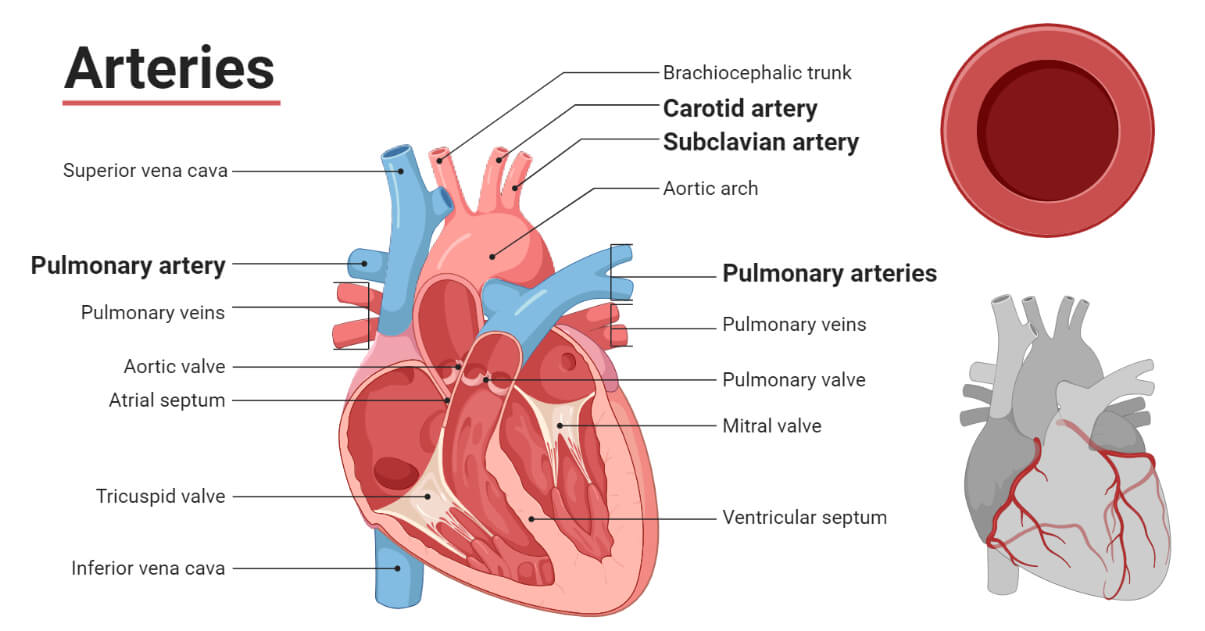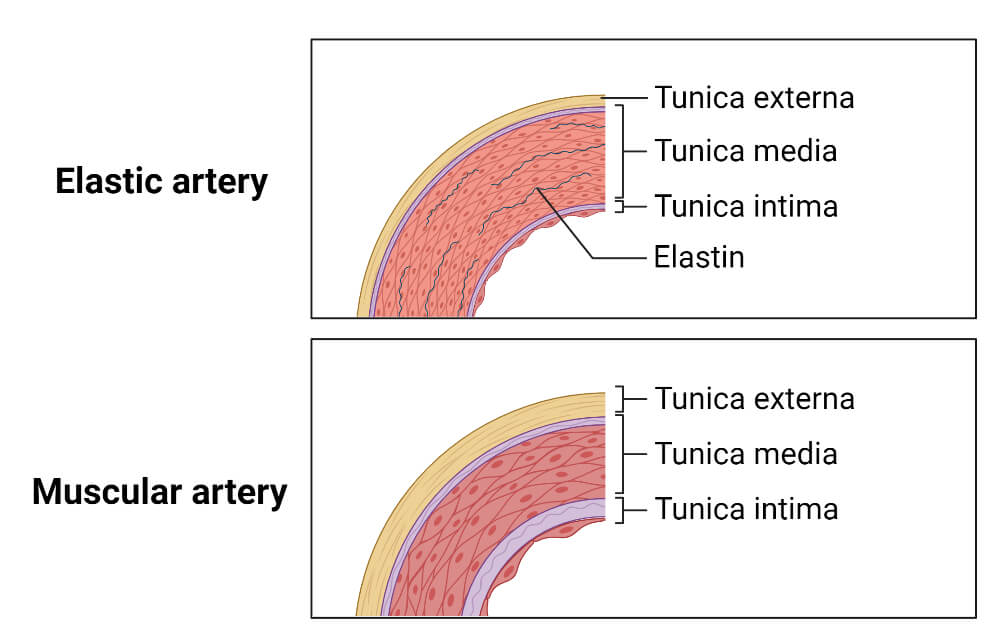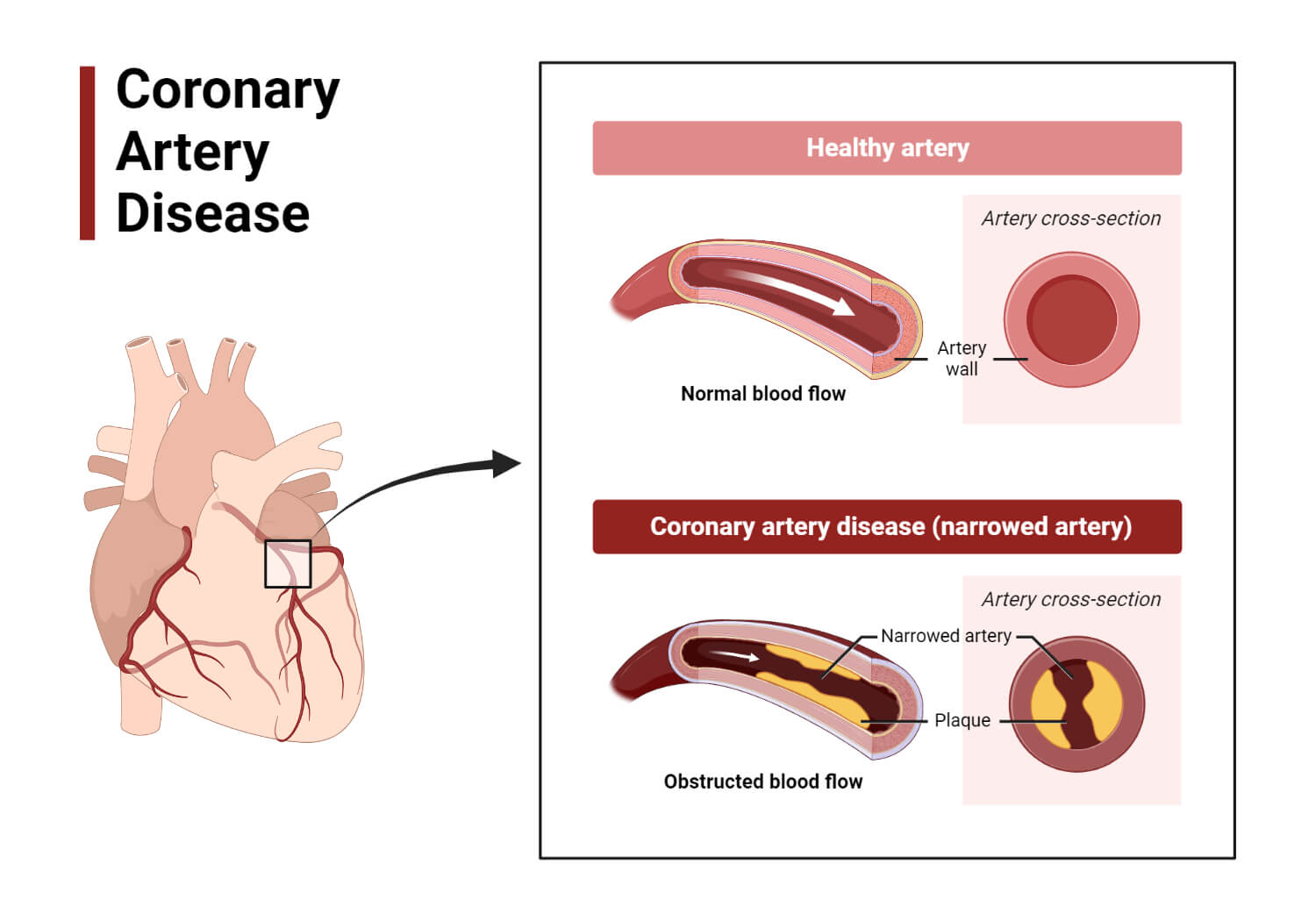Arteries are the elastic, muscular tubes (blood vessels) responsible for carrying the blood away from the heart and distributing it to several other organs and tissues. Simply, the blood vessels that carry blood away from the heart are arteries.

- All arteries carry the oxygenated blood except the pulmonary arteries, which carry the deoxygenated blood from the right ventricle to the lungs for purification, and the umbilical arteries, which supply deoxygenated blood to the placenta from the fetus.
- Arteries carry the blood at a high pressure, of about 120 mm of Hg; hence they are thick, muscular, and robust in nature to sustain the pressure and do not need valves to check the backflow of the blood. Hence, they are valveless thick-walled blood vessels.
- Artery arises from the left ventricle of the heart as a single main and largest artery called the aorta. The aorta is divided into four sections – ascending aorta, aortic arch, thoracic aorta, and abdominal aorta. From each section, different arteries, called the major arteries arise. These major arteries branch repeatedly to form a network of systemic arteries that supply blood to all organs and tissues of the body. The arteries become finer and finer as they branch out, and finally become arterioles; the finer arteries that supply to tissues. These arterioles further become smaller and are connected to capillaries to supply blood to every cell of the body.
Interesting Science Videos
Structure of Arteries
Arteries are thick-walled, muscular, and valveless blood vessels. Anatomically, the wall of the artery is made of three layers, the tunica externa, the tunica media, and the tunica intima.
- Tunica Externa
It is the outermost layer of arteries, also known as tunica adventitia. It is primarily composed of connective tissue made of collagens and elastic tissues.
This layer attaches arteries to the surrounding tissues and provides structural support. This layer sustains the blood pressure and checks overexpansion of the arteries.

- Tunica Media
It is the middle layer primarily composed of smooth muscle fibers arranged circularly. It also contains some amount of collagen and elastic tissues.
In smaller arteries and arterioles, smooth muscle cells are abundant; whereas, in larger arteries and aorta, collagen and elastic tissues are in considerable amounts.
Tunica media functions to control the diameter of arteries; hence regulating the blood pressure and the blood flow.
- Tunica Intima
It is the thinnest and the innermost layer of the arterial wall. It is primarily composed of smooth endothelial cells. A single-layer simple squamous epithelial layer surrounded by a very thin layer of connective tissue with elastic fiber form this layer.
This layer provides a smooth surface for easy flow of blood and also prevent from a blood clot. This layer is also known to release proteinaceous substances that regulate the arterial diameter.
Types of Arteries
Based on the structure, arteries are mainly classified into 2 main types, viz. elastic arteries and muscular arteries.
- Elastic Arteries
These are the arteries that have a considerable amount of elastic fibers as their structural component in their tunica media layer. These arteries can expand and contract more significantly than other arteries due to the presence of elastic fibers. The Aorta, major branches of the aorta, and other major arteries (larger arteries) are elastic arteries.
- Muscular Arteries
These arteries have a low amount of elastic fibers in the tunica media but contain a very high proportion of muscle cells. These arteries are branches of major arteries and function to supply blood to organs and tissues.
Based on the types of blood they carry and the location of delivery, arteries can be classified into two types, viz. pulmonary arteries and systemic arteries.
- Systemic Arteries
These arteries supply oxygenated blood from the left ventricle to every tissue of the body for cellular respiration and nutrient circulation.
- Pulmonary Arteries
These arteries carry deoxygenated blood collected by veins from the right ventricle to the lungs for re-oxygenation i.e. exchange of metabolic CO2 with the atmospheric O2 at the alveoli of the lungs.
Some of the major arteries are summarized in the table below.
| The Sections of the Aorta | ||||
| Ascending Aorta | Aortic Arch | Thoracic Aorta | Abdominal Aorta | |
| Major Arteries Arising from the Sections of the Aorta | The left and the right coronary arteries | Brachiocephalic trunk Left common carotid artery Left subclavian artery Axillary artery Branchial artery Radial and ulnar artery | Intercostal arteries (10 pairs) | Celiac trunk Superior mesenteric artery Renal arteries Gonadal arteries Lumbar arteries Inferior mesenteric artery Common iliac arteries |
Functions of Arteries
- Systemic arteries carry the oxygenated blood from the heart to every organ and tissue of the body. Hence, their major function is to transport oxygen, nutrients, hormones, and other biomolecules or components to every part of our body.
- The elasticity of the arterial wall functions to propel the blood together with the pumping action of the heart.
- Pulmonary arteries carry the deoxygenated blood from the right ventricle to the lungs for oxygenation.
Arteries and Diseases
Arteries suffer from various medical conditions called arterial diseases. They may be infectious diseases caused by microorganisms or maybe other non-infectious medical conditions.

Some of them are tabulated below:
| Disease | Introduction |
| Aortic Disease | The conditions where the aorta experiences some abnormalities like dilation and bulging of the wall (aneurysm). |
| Coronary Artery Disease | Condition when the coronary arteries fail to transport blood smoothly to the heart muscles due to blockage or inflammation. |
| Peripheral Artery Disease | Condition when the systemic arteries fail to transport blood smoothly due to blockage or inflammation or constriction. |
| Pulmonary Embolism | Condition due to blockage of an artery supplying to the lungs mostly due to the formation of a blood clot. |
| Atherosclerosis | Development of abnormalities called lesions in the arterial walls and stiffening of the arterial walls. |
References
- Ross & Wilson Anatomy & Physiology in Health and Illness. 13th ed. Churchill Livingstone Elsevier. ISBN 978-0-7020-7276-5
- What are Blood Vessels? Types, Layers and Functions – An Overview (byjus.com)
- Blood vessel | Definition, Anatomy, Function, & Types | Britannica
- The Types of Blood Vessels in Your Body (thoughtco.com)
- Classification & Structure of Blood Vessels | SEER Training (cancer.gov)
- Medical Definition of Artery (rxlist.com)
- Artery. (2023, April 18). In Wikipedia. https://en.wikipedia.org/wiki/Artery
- Arteries of the Body: Picture, Anatomy, Definition & More (healthline.com)
- Britannica, The Editors of Encyclopaedia. “artery”. Encyclopedia Britannica, 18 Mar. 2023, https://www.britannica.com/science/artery. Accessed 25 May 2023.
- Arteries: What They Are, Anatomy & Function (clevelandclinic.org)
- 18.2: Structure and Function of Blood Vessels – Medicine LibreTexts
- Clogged Arteries (Arterial Plaque) – Causes, Dangers, Tests, Treatment (webmd.com)
- Structure and function of blood vessels – Structure and function of arteries, capillaries and veins – Higher Human Biology Revision – BBC Bitesize
- Artery Structure, Function, and Disease (thoughtco.com)
- Major arteries, veins and nerves of the body: Anatomy | Kenhub
- The Role of Arteries in the Circulatory System (verywellhealth.com)
- Arteries: Function, anatomy, and types (medicalnewstoday.com)
